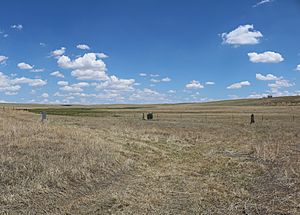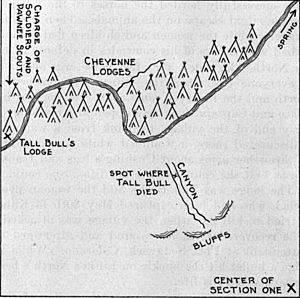Battle of Summit Springs facts for kids
Quick facts for kids Battle of Summit Springs |
|||||||
|---|---|---|---|---|---|---|---|
| Part of Comanche War, American Indian Wars | |||||||
 The Battle of Summit Springs site showing three of the memorials |
|||||||
|
|||||||
| Belligerents | |||||||
| Arapaho Cheyenne Sioux |
|||||||
| Commanders and leaders | |||||||
| Tall Bull † | |||||||
| Strength | |||||||
| 244 soldiers 50 scouts |
~450 men, women and children | ||||||
| Casualties and losses | |||||||
| 1 wounded | ~35 killed 17 captured |
||||||
| Civilian Casualties 1 killed 1 wounded | |||||||
The Battle of Summit Springs happened on July 11, 1869. It was a fight between the United States Army and a group of Cheyenne Dog Soldiers. The US Army was led by Colonel Eugene Asa Carr. The Cheyenne group was led by Tall Bull, who died during the battle.
The US forces were sent to stop a series of attacks in north-central Kansas. These attacks were carried out by Chief Tall Bull's Dog Soldiers. The battle took place in Washington County, Colorado, south of Sterling, Colorado.
Contents
What Happened at Summit Springs?
The Army's Plan
Pawnee Scouts helped the US Army find Tall Bull's village. These scouts were led by Major Frank North. Colonel Carr was a skilled leader, sometimes called "The Black-Bearded Cossack." He planned his attack carefully.
Colonel Carr had 244 soldiers from the 5th United States Regiment of Cavalry. He also had 50 Pawnee Scouts. They attacked the village from three sides at once. The people in the village were not expecting the attack.
A Brave Young Man
Captain Luther North, from the Pawnee Scout Battalion, told a story about the battle. He saw a Cheyenne boy, about 15 years old, herding horses. The boy was about half a mile away from the army's line.
The soldiers were very close before the boy saw them. He quickly jumped on his horse. He gathered his herd and bravely drove them into the village. Soldiers were shooting at him, but he kept going. He could have ridden away on his fast horse. But he chose to save his herd. At the edge of the village, he joined other warriors. They were trying to hold back the soldiers. This allowed the women and children to escape. The young boy died fighting like a true warrior. Captain North said, "No braver man ever existed than that 15 year old boy."
The Fight Continues
Major Frank North saw an American Indian rise from cover and aim at him. Major North shot and killed the man. It turned out to be Chief Tall Bull.
Meanwhile, the Pawnee Scouts surrounded about 20 Cheyenne warriors. These warriors were hiding in a deep ditch called a ravine. They only had bows and arrows to fight with. They held off their attackers until they ran out of arrows. Then, the Pawnees moved in and killed them all.
After the Battle
According to an expert named George Bird Grinnell, 35 people were killed in total. Even though the 5th Cavalry soldiers had more fighters, the Pawnee Scouts seemed to be more successful in the fighting.
One Cheyenne warrior escaped on Tall Bull's special white horse. The next day, Scout William Cody (Buffalo Bill) shot him off the horse during a small fight. This made Cody believe he had killed Tall Bull. However, Frank North, who was partners with Cody in the cattle business, later shared details that showed Luther North's story of the shooting was correct.
Colonel Carr reported that only one of his soldiers was wounded. He claimed that 52 American Indians were killed. Seventeen women and children were captured. More than 300 horses and mules were also taken. Sadly, one captive, Susanna Alderdice, died, and another, Maria Weichell, was injured.


